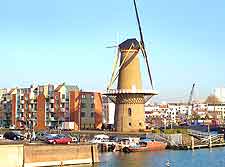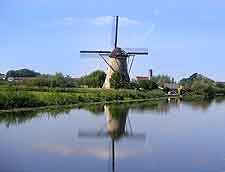Rotterdam History Facts and Timeline
(Rotterdam, South Holland, Netherlands)

Rotterdam began as a small settlement on the River Rotte, at the place where the river met with the Nieuwe Maas. At that time, it was little more than a fishing village.
In the latter part of the 13th century, a dam was built here in an attempt to reclaim some of the boggy land for development. In 1340, Rotterdam was granted a city charter by Count Willliam IV.
Medieval History
During the early medieval period, Rotterdam had a great deal going in its favour. In particular, its harbour was both accessible and deep. What's more, it was ideally placed to access some of the main European trade routes. As a consequence, the city grew at a rapid pace.
Throughout its history, Rotterdam has had its fair share of troubles. One such incident took place in 1488, when Frans van Breederoode and his followers managed to inflict quite considerable damage on the city. Later, a fire broke out in Rotterdam, burning down many of its buildings.
During the 16th-century war with Spain, Rotterdam rose to prominence, primarily because the trading centres of
Amsterdam and
Antwerp were cut off. New docks were dug from 1590 onwards. This was a time of great prosperity for the city and it was to continue throughout the 17th century.
From the late 1700s, however, history documents report that the number of ships calling at Rotterdam's port started to fall. It is thought that one problem the city may have encountered was the silting up of the Maas estuary, which prevented larger ships from entering the port to deposit their cargoes. Another obstacle was the Fourth Anglo-Dutch War. At any rate, the city's population failed to grow as it had done previously.

Modern History
When the Industrial Revolution arrived here in the 19th century, Rotterdam finally came into its own. The city grew at an astonishing rate. New innovations arrived, such as steam power and mechanised cranes. Along with the introduction of the railway, they helped to revolutionise the way that the port worked. Part of the modernisation of the city included the construction of bridges to connect the two banks of the river. In 1872, the 'New Waterway' opened. Commodities could now be transported from Rotterdam directly to the North Sea.
Expansion continued until the 1930s. Like many large industrial cities, the worldwide depression was keenly felt here. Increasing levels of poverty were experienced in the city. Matters were made worse during World War Two, when the city suffered extensive bomb damage. Within a short period of time, there was little left of its original medieval architecture. Even worse, Rotterdam had to endure five years of German occupation.
The 1950s marked the start of the city's recovery. With little left to restore, developers could start with a relatively clean state. Today, Rotterdam is very much a modern city, although a few remnants of its past have survived. As the world's second-biggest port, Rotterdam plays a key role in the economy of the Netherlands.
 Rotterdam began as a small settlement on the River Rotte, at the place where the river met with the Nieuwe Maas. At that time, it was little more than a fishing village.
Rotterdam began as a small settlement on the River Rotte, at the place where the river met with the Nieuwe Maas. At that time, it was little more than a fishing village.